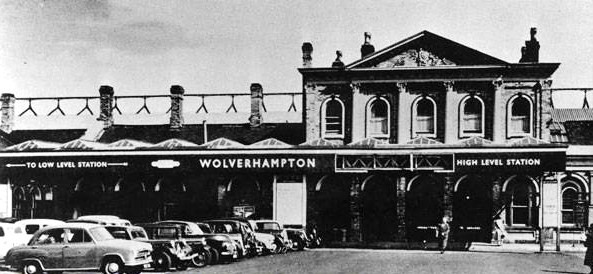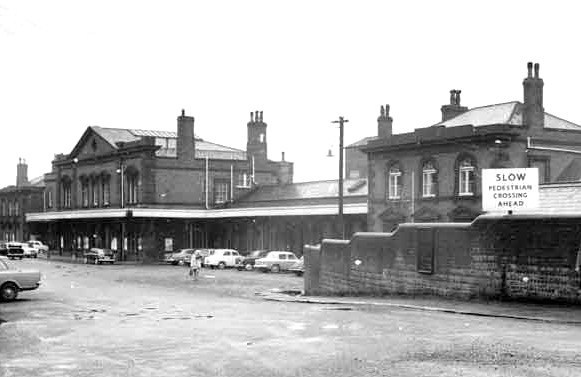 Above, High level station before the rebuild. below Low level station  |
The Railway in Wolverhampton. It would be impossible to talk about Wolverhampton without mentioning one of the key industries in the town during the 19th and 20th centuries, the railways. It is believed that the first station in the town was located on the wednesfield road, just past Heath town. When Isambard Kingdom Brunel started work on the Low level station for the Oxford, Worester & Wolverhampto railway he first built it on his broad guage system. However costs and other considerations forced the introduction of the standard guage track. When the low level station was closed, parts of the broad guage system were found. After the coming together of railway companies low level became the towns GWR station. High level station was the LMS terminal and its tracks ran almost in line with each other in and out of town. The other noteworthy railway building in the town, which is still there, is the Queens arch,an original departure point on the railway. This building was incorporated into the new 2011 bus station. Along with the trains came the workshops, places where my generation hung out trainspotting before we discovered beer and girls. Both rail networks had workshops in the town where steam locomotives were readied for a days work or repaired when things went wrong or purely due maintenance. Working on the railway was hard and very dirty work. It involved heavy machinery and could be dangerous. Engine cleaning and readiness was pretty involved, the firebox had to be raked out, the smoke box had to be cleaned, the oil boxes had to be filled, the engine had to be coaled and watered. After the first post war Labour government decided to use the war time system of integrated rail companies as they nationalised them. Following the war, the railways were in bad shape, the luftwaffe, cut back maintenance schedules and the lack of cash to carry out repairs meant that things were going from bad to worse. As a kid, i could travel to Birmingham on the Low level and return on high level thus improving my chances during train spotting expeditions. Trains were incredibly cheap to ride on, you could go to Brum cheaper and quicker by train than by bus. By the early1960's with the introduction of Diesel loco's with their less demanding maintenance schedules and easier working practices, it was easy to see which way the wind was blowing for the towns railways. When coupled with the dreaded Beeching axe it spelt the end for workshops in the town. The coming of the motorways also meant that more goods could be transported by road and so the goods depots such as Wednesfield road and Herbert street would no longer be needed. Suburbs of the town such as Tettenhall and Wombourne lost the railway as did several other places such as Dunstall hill racecourse halt. Sadly it soon became obvious that BR wanted only one station in the town, in my view a mistake as there is a case for some duplication of services or not putting all your transport eggs in one basket . The end result was the closure of low level with all its history. I know the building is still there but its tracks, glass canopy and other items have long since gone. The only thing left is the archway that used to link the two stations. This wonderfull architectural feature has a history of its own dating back as it does to the inception of the railway in the town. The ironic thing is that the only remaining link to the railway by low level is the Great Westen inn. A journey to Wales by train was always memorable, in the early 50's they were still using none corridor coaches so you made sure you went at low level before getting on the train. As the train left the town it had to pass the gasworks, woe betides anyone with their head out of the carriage window, the stink was almost unbearable. Fortunately by the time the train was a few miles away the air was much better. Does anyone remember BR food? my guess is yes you do, from the rock hard rock cakes to the square Lyons individual fruit pies. During the 50's none corridor coaches were still in use, a long journey could be quite uncomfortable if the passenger did not use the station facilities before embarking on a long journey. |